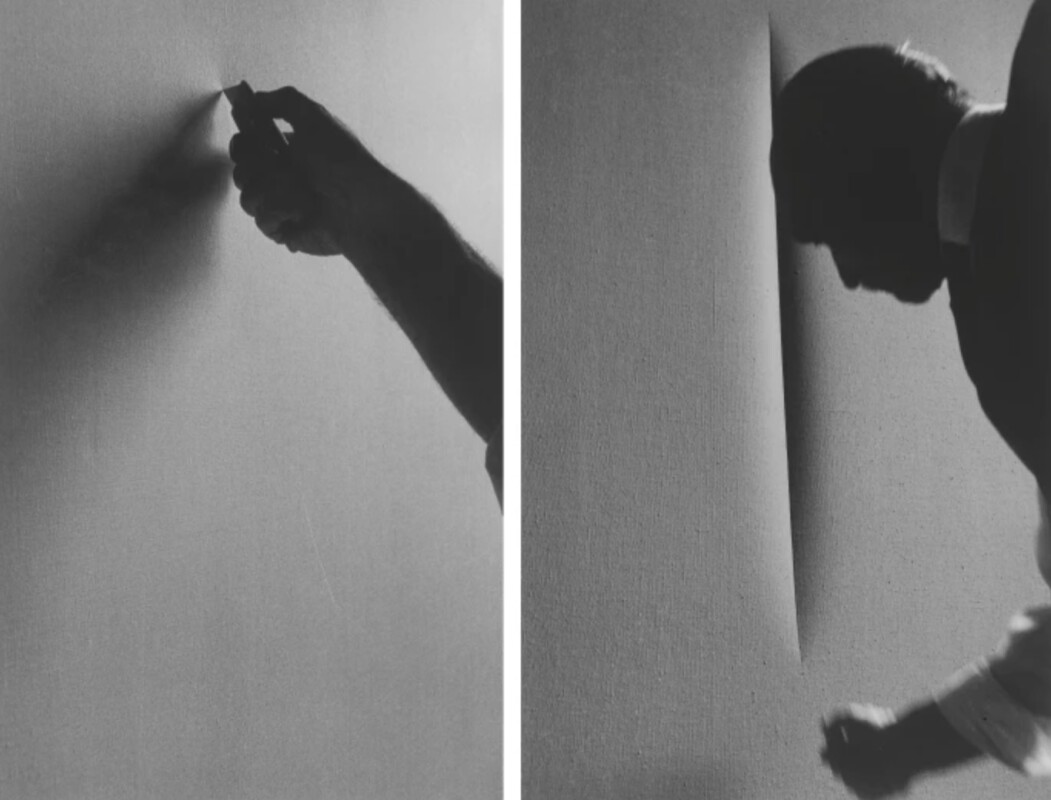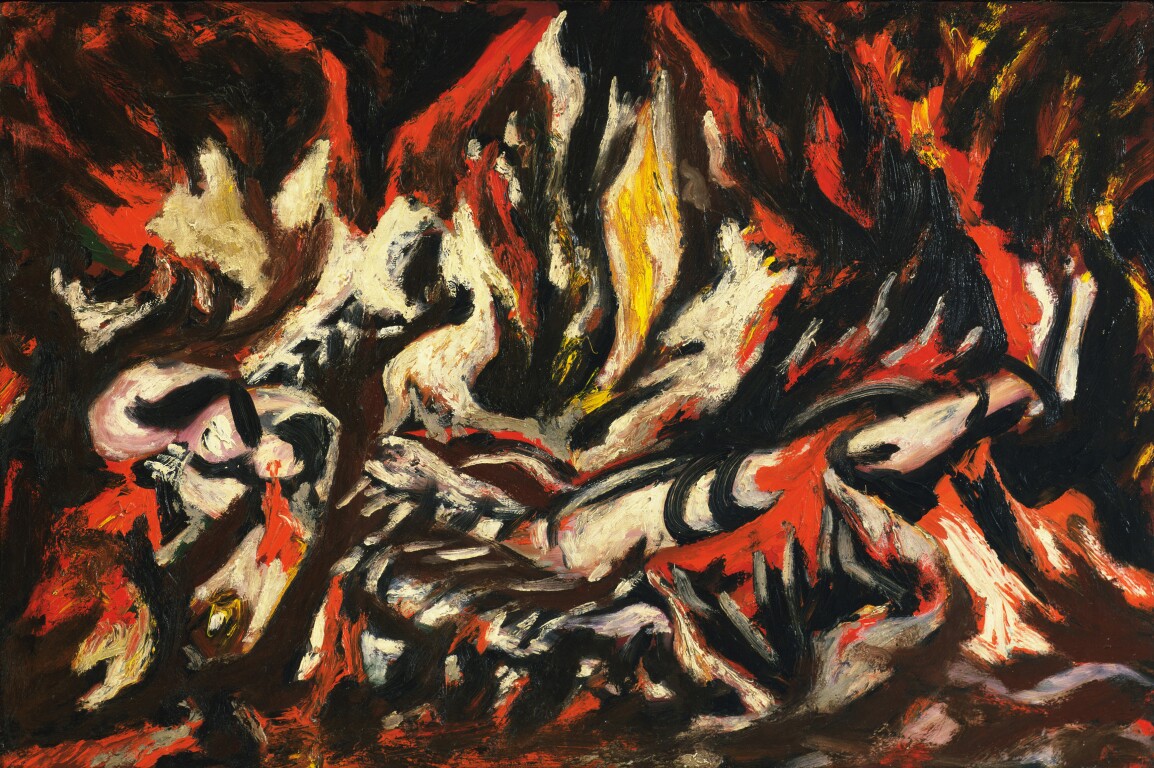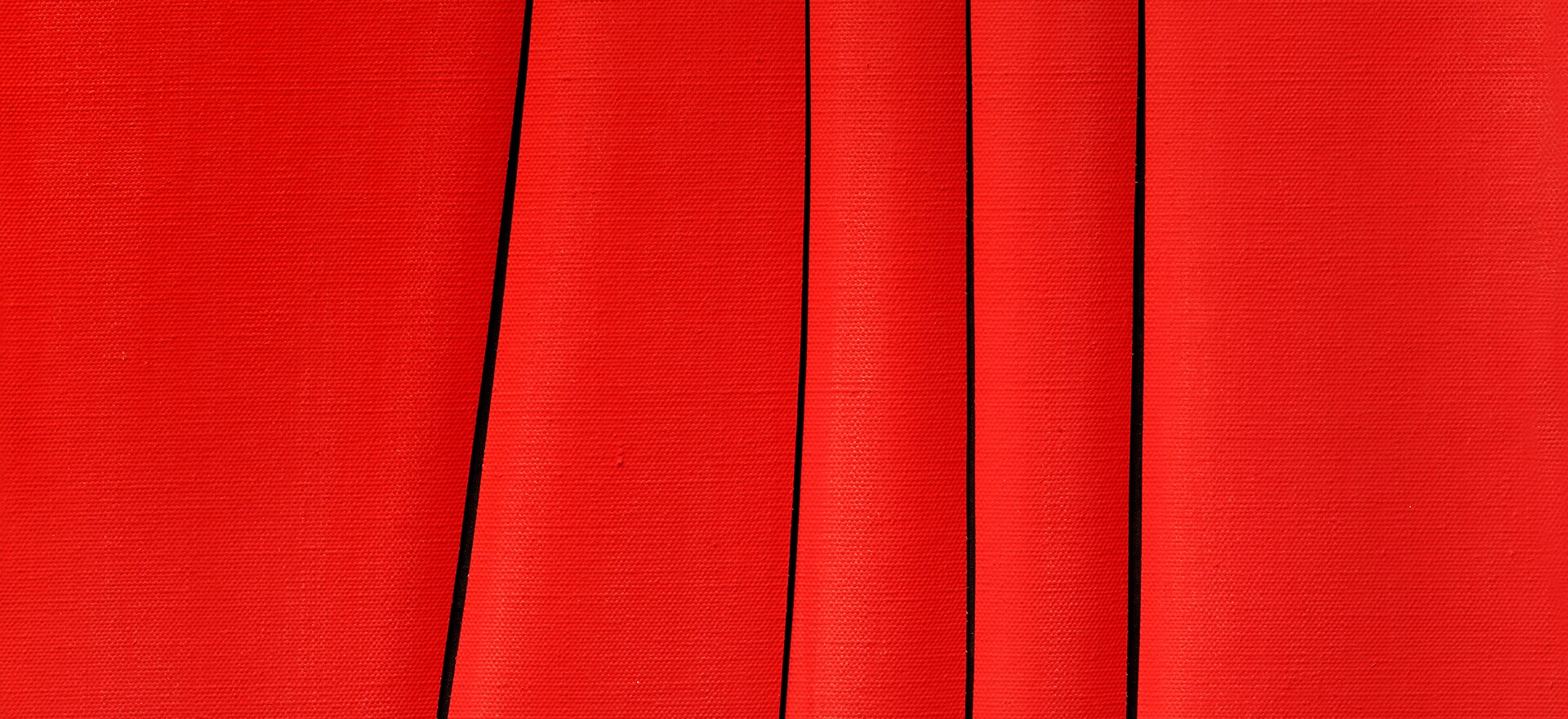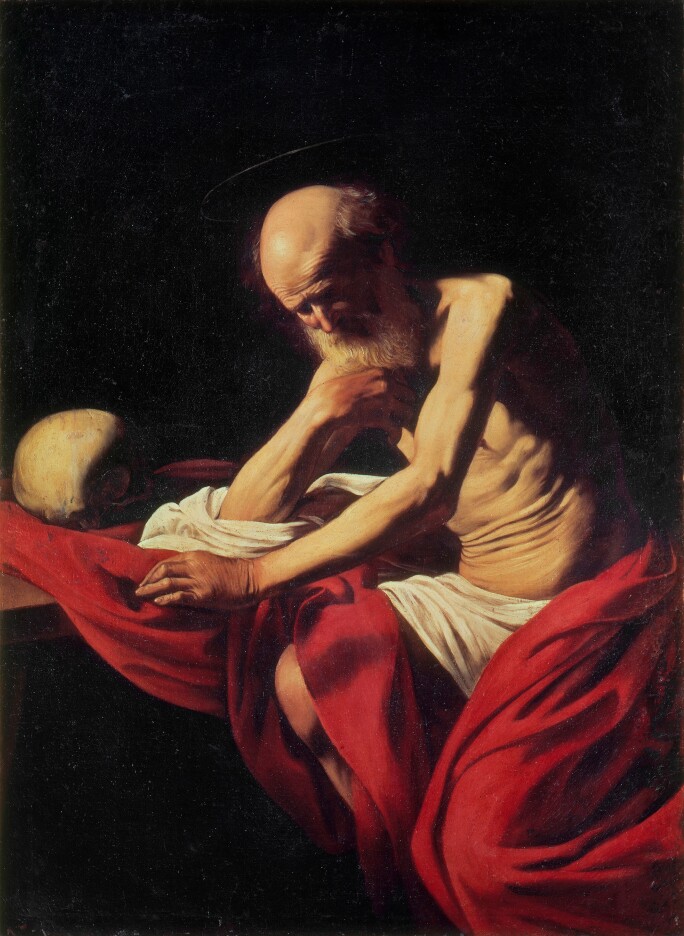Lucio Fontana’s rhythmic and elegant Concetto spaziale, Attese from 1966 comprises a majestic progression of four assured incisions across a pristine red canvas: An archetypal exemplar of the artist’s famed Tagli series rendered in its most poweful colour. The sheer vitality of the intense scarlet pigment is immediately impactful, its saturated power amplified through contrast with the plunging black voids. Bristling with connotative energy, this canvas is charged with the red of passion and action – of warmth, danger, and violence. Its abundant richness is only tempered by the punctuating presence of the four deep slashes, each imbued with the subtlest of cursive curves and, as a group, seeming to lengthen and amplify from right to left, as if part of an immutable crescendo of beauty and brutality.

Image: © Ugo Mulas © Ugo Mulas Heirs, All Rights Reserved.
Artwork: © 2020 Lucio Fontana/ DACS
The artistic theory behind the creation of the Tagli (cuts) was professed in Fontana’s Manifiesto Bianco, published in 1946. Here Fontana proposed the birth of a new Spatialist art, which sought to articulate the fourth dimension. In this quest, Fontana proposed the artist as the source of creative energy, anticipating future events and engaging with technological advancement; asserting that the artist’s work should aspire to enlighten ordinary people to the possibilities offered by their environment and society. Ever since first puncturing a canvas in 1949, the artist had been singularly committed to the Spatialist mission to explore the conceptual depths beyond the limits of the two-dimensional picture plane.

Private Collection
Artwork: © Lucio Fontana/SIAE/DACS, London 2022
Fontana embarked on the Tagli at the end of 1958, partly in response to the developments in contemporary art in Italy during 1957-58, particularly Yves Klein’s first exhibition of monochrome paintings in Milan in 1957, Jackson Pollock’s retrospective in Rome in 1958, and the predominant rise of Art Informel. In response to the contemporary turn toward action painting at this time, Fontana’s cuts evoked this gestural performance while seeking the realisation of a more metaphysical presence. Fontana combined the highly saturated monochromatic purity of Klein’s canvases with Pollock’s violently physical action. However, whereas Pollock’s painterly dripping technique left an indexical record of his every movement, Fontana’s gesture annihilated this proclivity toward additive mark-making and replaced it with a vandalistic destructiveness. Drawing attention to the materiality of the picture-plane, Fontana’s cuts question classical interpretations of a ‘figure-ground’ relationship; rather than striving toward an illusion of perspectival depth, Fontana’s punctures create forms within the canvas that embody a real third dimension of space. Moreover, the painting’s chromatic radiance amplifies the profound darkness of the plunging black recesses that aptly signify Fontana’s quest for "the Infinite, the inconceivable chaos, the end of figuration, nothingness" (Lucio Fontana quoted in Exh. Cat., London, Hayward Gallery, Lucio Fontana, 1999, p. 198).

The Museum of Modern Art, New York
Image: © The Museum of Modern Art, New York/Scala, Florence
Artwork: © The Pollock-Krasner Foundation ARS, NY and DACS, London
By the 1960s, Fontana’s practice of breaking through the canvas and into a heretofore unexplored territory beyond had gained newfound relevance alongside ground-breaking concurrent advances in space travel. The ‘Space Race’ had established the moon as the next frontier for human exploration and dominated the global political zeitgeist. As such, Fontana was at pains to emulate this scientific paradigm shift in his artistry: Just as Yuri Gagarin broke through the atmosphere to reveal the void behind it, Fontana irrevocably changed the course of art. To this end, the telleta (the strips of black gauze positioned behind each cut) are as central to the interpretation of the present work as the narrow slits themselves. They imply the blackness of space and the insurmountable nothingness of the cosmological void. Fontana was explicit with regard to his emulation of the cosmic explorations of his era, and confident in the implication that his actions had for the course of art history: “The discovery of the Cosmos is that of a new dimension, it is the Infinite: thus I pierce the canvas, which is the basis of all arts and I have created an infinite dimension, an x which for me is the basis for all Contemporary Art.” (Lucio Fontana quoted in Exh. Cat., New York, Solomon R. Guggenheim Museum, Lucio Fontana: Venice/New York, 2006, p. 19).


Museu de Montserrat, Montserrat
Image: © Scala, Florence www.scalarchives.com
Despite these intimations of infinite cosmological serenity, there is also an inherent sense of violence to the present work. The four striations that permeate its surface are unmistakably cuts wrought by a human hand; their wound-like appearance is enhanced by the ineluctable smoothness of the pulsating red pigment, saturating the canvas, and seeping from each cut. In this way, the present work almost appears as a contemporary echo of the wounds of Christ on the cross. Christian art delivered the message of salvation through sacrifice, just as in Fontana’s work it is only by enacting the violence on an unblemished surface that the intimation of a new dimension can be attained. Thus, in a manner typical of his subversive artistic voice, in Concetto spaziale, Attese, Fontana denigrated the techniques of the Christian art tradition – perspectival recession, oil paint modelling – whilst simultaneously updating and recapitulating that Christian notion of achieving transfiguration through pain and sacrifice. Concetto Spaziale, Attese is a work that distils the past, present, and future into a captivating composition of striking simplicity; a prime example of the manner in which Lucio Fontana was able to instigate a paradigm shift in post-war art, galvanising the discourse to keep up with concurrent progressions in space travel. It is works of this nature and of this exceptional quality and rarity that have installed Fontana’s oeuvre at the pinnacle of Italian post-war art.